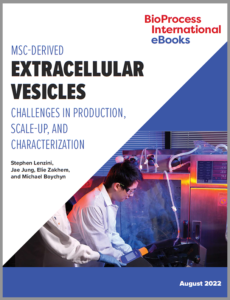eBook: MSC-Derived Extracellular Vesicles Challenges in Production, Scale-Up, and CharacterizationeBook: MSC-Derived Extracellular Vesicles Challenges in Production, Scale-Up, and Characterization
Sponsored by ATCC
 The discovery of extracellular vesicles (EVs) as an intercellular communication medium has led to explorations of their therapeutic potential. EVs constitute a heterogeneous mixture of several different vesicle populations that may be similar in size but different in content, or vice versa. The vesicles can contain RNAs and proteins as well as DNAs and lipids as biological cargoes. Those cargoes can exist either intraluminally within EVs or on their surface, adding complexity to analytical considerations.
The discovery of extracellular vesicles (EVs) as an intercellular communication medium has led to explorations of their therapeutic potential. EVs constitute a heterogeneous mixture of several different vesicle populations that may be similar in size but different in content, or vice versa. The vesicles can contain RNAs and proteins as well as DNAs and lipids as biological cargoes. Those cargoes can exist either intraluminally within EVs or on their surface, adding complexity to analytical considerations.
EVs are classified into subpopulations defined by their subcellular origins. Exosomes are a therapeutically promising subclass of EVs typically described as small, with diameters of 40–160 nm, and form inside cells by budding inward within endosomes to form multivesicular endosomes (MVEs).
The largest group of preclinical and clinical studies currently involving therapeutic EVs focuses on those derived from mesenchymal stromal cells (MSC). Over the past decade, the innate therapeutic capabilities of MSC-EVs have been demonstrated against more than 15 preclinical disease indications, including liver, heart, kidney, neurodegenerative, and lung diseases. But what technologies and processes will support large-scale MSC-EV production? The authors discuss concerns for MSC-EV characterization, dosing, upstream production, and downstream processing. They conclude by pointing to remaining challenges in creating a supply of MSC‑EVs for current and future clinical studies.
Fill out the form below to read the eBook now.
You May Also Like






